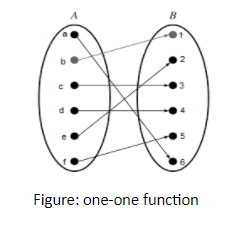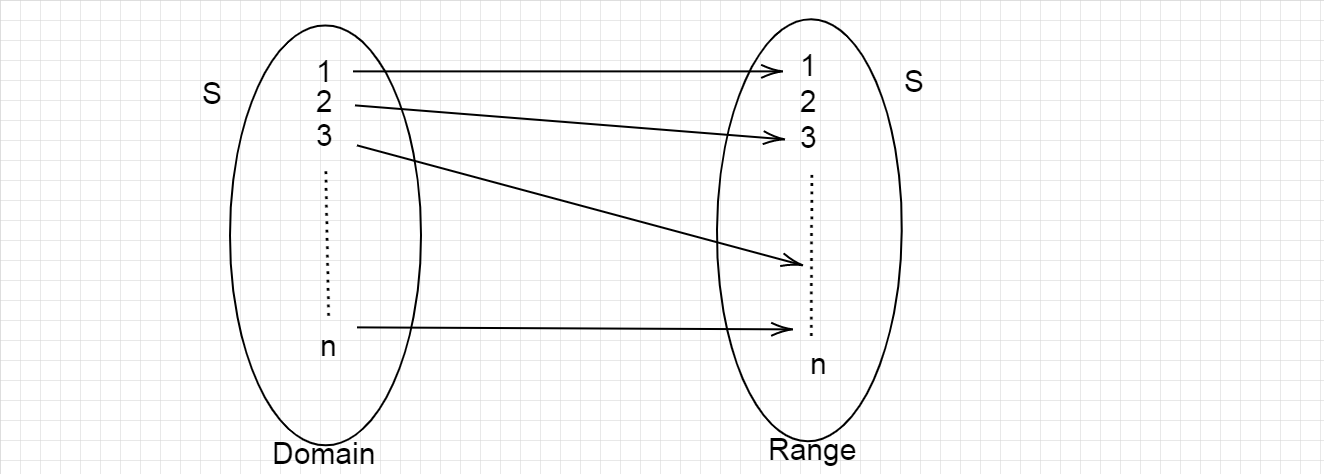
One mapping is selected at random from all mappings of the set \[S = \{ 1,2,3,....,n\} \] into itself. If the probability that mapping is one-one is $\dfrac{3}{{32}}$ then the value of n is ?
A) 2
B) 3
C) 4
D) None of these
Answer
589.2k+ views
Hint: A relation $\mathbb{R}:{\text{ A}} \to {\text{B}}$is defined as a function if every element of set A is mapped to one element of set B, i.e. , each object has only one image.

One-one function: When each element of set B is mapped to only one element of set A, i.e., each object in set A has a unique image in set B, then the function is called one-one function.
Let the number of elements in set A = n(A) = a
The number of elements in set B = n(B) = b
Necessary condition : ${\text{b }} \geqslant {\text{ a}}$ [ for one-one function $f:{\text{ A}} \to {\text{B}}$] …… (1)
Total number of functions $ = \mathop {\text{b}}\nolimits^{\text{a}} $ …… (2)
Number of one-one functions \[ = C({\text{b,a)}} \cdot {\text{a!}}\] $(\because 'C'{\text{is combination)}}$ …… (3)
Complete step by step solution:
The mapping of set \[S = \{ 1,2,3,....,n\} \] into itself can be drawn as,

Where the image of every element \[x\] in the domain, there exists an element \[f(x)\] in the range.
Step 1
Given set \[S = \{ 1,2,3,....,n\} \]
Step 2
Function $f:{\text{ S}} \to {\text{S}}$is defined. $(\because {\text{given}})$
Step 3
Number of elements in set S = n(S) = n.
Total number of functions \[f:{\text{ S}} \to {\text{S = }}\mathop {{\text{ }}n}\nolimits^n \] (from (2)) …… (4)
Step 4
Number of one-one functions $f:{\text{S}} \to {\text{S = }}C({\text{n,n)}}{\text{.n}}!$ (from (3))
$ = {\text{n!}}$ …… (5)
Step 5
Probability (selecting mapping is one-one) = \[\dfrac{{{\text{number of one - one functions }}f:{\text{S}} \to {\text{S }}\;}}{{{\text{total number of functions }}f:{\text{S}} \to {\text{S}}}} = \dfrac{3}{{32}}\]
$(\because {\text{given}})$
$ = \dfrac{{{\text{n!}}}}{{\mathop {\text{n}}\nolimits^{\text{n}} }} = \dfrac{3}{{32}}$ (from (4) and (5)) $\therefore $ n = 4 [by inspection]
Therefore, the correct option is (C), n=4.
Note:
Another classification of functions is onto functions. If for functions $f:{\text{A}} \to {\text{B}}$the co-domain set of B is also the range for the function, then the function is called an onto function.
The functions which are both one-one and onto are called bijective functions.

One-one function: When each element of set B is mapped to only one element of set A, i.e., each object in set A has a unique image in set B, then the function is called one-one function.
Let the number of elements in set A = n(A) = a
The number of elements in set B = n(B) = b
Necessary condition : ${\text{b }} \geqslant {\text{ a}}$ [ for one-one function $f:{\text{ A}} \to {\text{B}}$] …… (1)
Total number of functions $ = \mathop {\text{b}}\nolimits^{\text{a}} $ …… (2)
Number of one-one functions \[ = C({\text{b,a)}} \cdot {\text{a!}}\] $(\because 'C'{\text{is combination)}}$ …… (3)
Complete step by step solution:
The mapping of set \[S = \{ 1,2,3,....,n\} \] into itself can be drawn as,

Where the image of every element \[x\] in the domain, there exists an element \[f(x)\] in the range.
Step 1
Given set \[S = \{ 1,2,3,....,n\} \]
Step 2
Function $f:{\text{ S}} \to {\text{S}}$is defined. $(\because {\text{given}})$
Step 3
Number of elements in set S = n(S) = n.
Total number of functions \[f:{\text{ S}} \to {\text{S = }}\mathop {{\text{ }}n}\nolimits^n \] (from (2)) …… (4)
Step 4
Number of one-one functions $f:{\text{S}} \to {\text{S = }}C({\text{n,n)}}{\text{.n}}!$ (from (3))
$ = {\text{n!}}$ …… (5)
Step 5
Probability (selecting mapping is one-one) = \[\dfrac{{{\text{number of one - one functions }}f:{\text{S}} \to {\text{S }}\;}}{{{\text{total number of functions }}f:{\text{S}} \to {\text{S}}}} = \dfrac{3}{{32}}\]
$(\because {\text{given}})$
$ = \dfrac{{{\text{n!}}}}{{\mathop {\text{n}}\nolimits^{\text{n}} }} = \dfrac{3}{{32}}$ (from (4) and (5)) $\therefore $ n = 4 [by inspection]
Therefore, the correct option is (C), n=4.
Note:
Another classification of functions is onto functions. If for functions $f:{\text{A}} \to {\text{B}}$the co-domain set of B is also the range for the function, then the function is called an onto function.
The functions which are both one-one and onto are called bijective functions.
Recently Updated Pages
Master Class 4 Science: Engaging Questions & Answers for Success

Master Class 4 English: Engaging Questions & Answers for Success

Master Class 4 Maths: Engaging Questions & Answers for Success

Class 4 Question and Answer - Your Ultimate Solutions Guide

The number of solutions in x in 02pi for which sqrt class 12 maths CBSE

Write any two methods of preparation of phenol Give class 12 chemistry CBSE

Trending doubts
One Metric ton is equal to kg A 10000 B 1000 C 100 class 11 physics CBSE

Discuss the various forms of bacteria class 11 biology CBSE

Explain zero factorial class 11 maths CBSE

What is 1s 2s 2p 3s 3p class 11 chemistry CBSE

State the laws of reflection of light

Difference Between Prokaryotic Cells and Eukaryotic Cells




